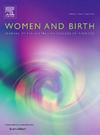Maternity care pathway and involvement in decision making: A mixed-methods study of women’s experiences in Ireland
IF 4.4
2区 医学
Q1 NURSING
引用次数: 0
Abstract
Background
In Ireland, maternity care is provided through a mixture of public and private services, with type of maternity care offered varying according to availability, clinical need and geographic location.
Aim
To explore women’s perceived involvement in decisions about care depending on the maternity care pathway received.
Methods
Mixed-methods secondary analysis of data from the Irish National Maternity Experience Survey 2020. Three care pathway groups reflecting maternity care provision in Ireland were created: public care with midwives and obstetricians in hospital, private/semi-private obstetric-led care and midwifery-led care. Hierarchical multiple regression determined the association between care pathways and involvement in decisions. Free-text comments from respondents were thematically analysed.
Findings
3205 women participated (50 % response rate). 64.75 % received public care, 24.11 % received consultant-led private/semi-private care and 11.13 % received midwifery-led care. Private/semi-private care and midwifery-led care were associated with greater perceived involvement in decisions during pregnancy compared to public care. Private/semi-private care was associated with greater perceived involvement in care decisions during labour and birth and decisions in hospital after birth compared to public care. Qualitative findings identified that involvement in decisions was supported by effective communication, continuity of relationship with healthcare professionals, availability of choice and support for women’s preferences.
Discussion
Levels of continuity of care provided by maternity care models in Ireland may account for differences in perceived involvement in decisions.
Conclusion
All maternity care pathways should strive to provide continuity of care to support women to make informed choices across all stages of their maternity care.
求助全文
约1分钟内获得全文
求助全文
来源期刊

Women and Birth
NURSING-OBSTETRICS & GYNECOLOGY
CiteScore
7.20
自引率
13.20%
发文量
371
审稿时长
27 days
期刊介绍:
Women and Birth is the official journal of the Australian College of Midwives (ACM). It is a midwifery journal that publishes on all matters that affect women and birth, from pre-conceptual counselling, through pregnancy, birth, and the first six weeks postnatal. All papers accepted will draw from and contribute to the relevant contemporary research, policy and/or theoretical literature. We seek research papers, quality assurances papers (with ethical approval) discussion papers, clinical practice papers, case studies and original literature reviews.
Our women-centred focus is inclusive of the family, fetus and newborn, both well and sick, and covers both healthy and complex pregnancies and births. The journal seeks papers that take a woman-centred focus on maternity services, epidemiology, primary health care, reproductive psycho/physiology, midwifery practice, theory, research, education, management and leadership. We also seek relevant papers on maternal mental health and neonatal well-being, natural and complementary therapies, local, national and international policy, management, politics, economics and societal and cultural issues as they affect childbearing women and their families. Topics may include, where appropriate, neonatal care, child and family health, women’s health, related to pregnancy, birth and the postpartum, including lactation. Interprofessional papers relevant to midwifery are welcome. Articles are double blind peer-reviewed, primarily by experts in the field of the submitted work.
 求助内容:
求助内容: 应助结果提醒方式:
应助结果提醒方式:


